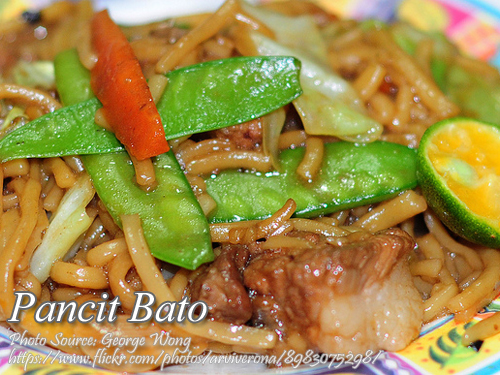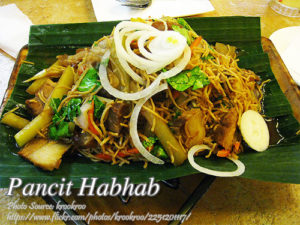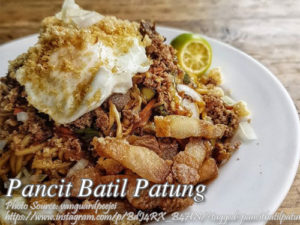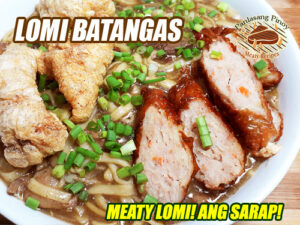This stir fried noodle dish is very similar to the well known pancit canton or pancit miki and the only difference is the noodles used in cooking this dish. Although it is called “pancit bato” which if you will translate it literally it will be “stone or rock noodles” but it is not the case. Before I knew this kind of pancit, I already heard about this from other people and read it online. I was thinking it was a unique kind of noodles used in this dish and in my mind I thought the noodles are hard as a rock.
And with some research I found out that the reason why it is called pancit bato is the place where it originate. It’s a town in Bato, Camarines Sur. The noodles are not so much different from the other noodles, it is also made from flour. It is processed by drying it under the sun which is the traditional way but it is also dried using an oven to speed up the process. Cooking this pancit is as easy as cooking pancit bihon or pancit canton with almost the same steps and procedures.
Pancit Bato Recipe: A Taste of Bato, Camarines Sur
Growing up, I had always heard my mom mention pancit bato, but it wasn’t until my Tita Luisa brought some over from her trip to Bicol that I finally got a taste of these special noodles. It wasn’t just the flavor that hooked me—it was the story behind it. Named after the town of Bato in Camarines Sur, it has become a beloved dish in the region, passed down from generation to generation. It has all the savory, comforting goodness of the more widely known pancit canton, but with a unique twist that’s all its own.
In my mind, I expected the noodles to be rock-hard because of the word “Bato,” which means “stone” in Filipino. But when I finally saw the noodles, they looked just like regular dried egg noodles, not much different from the pancit miki or pancit canton I grew up with. What makes this unique is not just the noodle but the way it’s sun-dried, or sometimes oven-dried, giving it that distinct flavor of home. Today, I’ll walk you through this dish and share a few family tips that have helped bring out the flavors of this beloved pancit.
The Origin and Heart of Pancit Bato
For a long time, the noodle dish remained a local specialty, known mostly in the Bicol region. Over time, however, its popularity spread to other parts of the Philippines, thanks to people like my Tita Luisa who brought it back with her. The noodles are crafted from simple flour, and in the old days, they were dried under the intense Bicol sun, which gives the noodles a more complex, deep flavor. This sun-drying process brings out a slight sweetness, with a hint of earthiness that’s hard to find in other noodles. Even today, some local producers continue this tradition, drying the noodles outdoors, while others use an oven to speed up production.
When my uncle, who’s originally from Camarines Sur, cooks this dish, he always says that the secret to this dish is the broth. He swears by a blend of pork and shrimp broth, a flavor combination that’s as rich as it is balanced. This was his little tip to me when I first tried to make it on my own: use both pork and shrimp, and you’ll get that full, satisfying taste that makes this pancit such a crowd-pleaser.
Cooking The Pancit Like a Local
The recipe for pancit bato is straightforward, but following each step with a little extra attention can make a big difference. Start by boiling pork in water, then set aside the broth for later. My Lola always taught us never to waste the broth—it’s the heart of any good pancit. Adding shrimp shells to the broth deepens the flavor and gives the dish that umami kick.
Once you have your broth ready, it’s time to sauté. In a large wok, heat a generous amount of oil and toss in finely chopped onion and garlic. The smell alone brings me back to my mom’s kitchen on a Sunday afternoon. Next, add the pork and shrimp, sautéing until they’re coated in oil and begin to brown. I was always told that browning the meat is essential, as it brings out the sweetness of the pork and adds depth to the pancit’s flavor. Once the pork and shrimp have mingled, pour in a bit of soy sauce, patis (fish sauce), and black pepper. This savory mix builds a solid foundation for the broth you’ll add shortly.
When the broth goes back in, the whole kitchen fills with a warm, comforting aroma. Let it simmer for a few minutes, allowing the flavors to meld together. Once it’s boiling, add the dried noodles. These noodles are hardy, and you’ll need to let them simmer in the broth until they soften and absorb that rich, savory flavor. My Lola would always cover the wok at this point, saying it helped the noodles cook evenly and allowed them to soak up more of the broth. If the dish starts to look dry, don’t be afraid to add a bit more water or broth.
After the noodles have softened, it’s time to add in the vegetables. Traditional choices include cabbage and carrots, which add a pop of color and sweetness to the dish. This is where the magic really happens, as the vegetables cook just until they’re tender but still have a bit of crunch. Finally, a dash of your favorite liquid seasoning helps you adjust the flavor exactly to your liking.
Serving and Enjoying Pancit Bato
Once everything is perfectly cooked, transfer the noodles to a large serving dish. If you want to make it extra special, garnish with slices of calamansi, which add a fresh, tangy flavor that cuts through the richness of the broth. My family loves to serve it with extra patis on the side for a bit more saltiness.
Every time I cook pancit bato, I can’t help but feel connected to the town of Bato, even though I’ve never actually been there. I think of my relatives who first taught me to cook it, and I can almost hear my Tita Luisa’s voice, telling me to be patient with the noodles, and to remember that a dish’s flavor deepens when cooked with care. This is more than just a noodle dish; it’s a reminder of tradition and family, and how food brings us all together.
A Little Food for Thought
Did you know that pancit bato is just one of many regional pancit variations in the Philippines? Each province seems to have its own unique take on the humble noodle, showcasing local ingredients and flavors. From pancit habhab in Lucban to pancit molo in Iloilo, these dishes tell a story about the people and places that created them.
Cooking this dish is a wonderful way to experience a piece of Bicol’s culinary heritage. It’s simple enough for a weeknight meal but carries with it the warmth and depth of a dish steeped in history. So the next time you’re in the mood for something comforting yet full of character, try this recipe. You might find yourself savoring not just the flavors but the stories that come with every bite.
How to Cook Pancit Bato
Ingredients
- 500 grams Pancit Bato dried noodles
- 2 cups pork boiled, cut into strips
- 1 cup medium size shrimp shelled
- 6 cloves garlic minced
- 1 pc white onion chopped
- 1 pc carrot sliced
- 1 pc red bell pepper cut into strips
- 1 cup snow peas sitsaro, stringed
- 1 cup green beans sliced
- 1 cup cabbage shredded
- 4 Tbsp. patis fish sauce
- 4 Tbsp. soy sauce
- 1/8 tsp. ground black pepper or to taste
- cooking oil
- liquid seasoning to taste
- kalamansi as condiment
Instructions
How to cook Pancit Bato:
- Boil the pork, drain and cut into strips. Bring the pork broth to a boil and add in the shrimp shells and head. Remove the shells and head from the broth and reserve the liquid for late use.
- In a large wok, heat oil and saute onion and garlic until aromatic. Add in pork and shrimp and saute for 3 minutes.
- Pour the soy sauce, patis and black pepper and saute for another 3 minutes. Pour 8 cups of pork and shrimp broth. Bring to a boil and simmer for another 5 minutes.
- Add in the noodles and cover. Simmer for about 5 to 8 minutes or until the dried noodles have absorbed most of the broth. You can add more water if it too dry.
- Next is add in the vegetables and cook for another 3 minutes or until the vegetables are cooked. Stir until all the ingredients are well mixed. Season with liquid seasoning according to our desired amount and taste.
- Transfer to a serving dish and serve with calamansi and patis as condiment.
Notes
Cooking Tips:
Use Pork and Shrimp Broth for Extra Flavor For a richer taste, make a broth using both pork and shrimp. Boiling the pork initially creates a flavorful base, and adding shrimp shells deepens the umami flavor. This combination gives the noodles a savory richness that makes this dish truly stand out. Simmer the Noodles to Absorb the Broth Allowing the pancit bato noodles to simmer in the broth ensures they soak up every bit of flavor. Cover the wok as the noodles cook to keep in the moisture, helping the noodles soften evenly. If the dish looks dry, add a splash of water or broth to maintain the perfect texture. Add Fresh Vegetables for Crunch and Color Cabbage, carrots, and other vegetables add texture and a hint of sweetness to balance the dish’s savory profile. Add them toward the end of cooking to keep their crispness and bright color. This not only enhances the dish visually but also adds a refreshing contrast to the rich, meaty noodles.






Well very delicious recipes I really loved your blog so helpful and 😋
Hi Tootsie, thank for the kind words! Really appreciate it!